BF3-OEt2 Catalyzed C3-Alkylation of Indole: Synthesis of Indolylsuccinimidesand Their Cytotoxicity Studies
Abstract
1. Introduction
2. Results and Discussion
2.1. Chemistry
Plausible Mechanism
2.2. Biological Evaluation
2.2.1. Structure Activity Relationship
2.2.2. Molecular Docking Studies
3. Materials and Methods
3.1. Preparation of Compounds
3.2. Biological Activity
4. Conclusions
Author Contributions
Funding
Institutional Review Board Statement
Informed Consent Statement
Data Availability Statement
Acknowledgments
Conflicts of Interest
Sample Availability
Appendix A. Experimental Section
Appendix A.1. Chemistry
Appendix A.2. General Procedure for the Synthesis of Compounds (3a–3x)
Appendix A.3. Biology
Cell Cultures, Maintenance and Anti-Proliferative Evaluation
Appendix A.4. Molecular Docking Study
Appendix A.4.1. Protein Preparation and Grid Generation
Appendix A.4.2. Ligand Preparation
Appendix A.4.3. Molecular Docking
References
- Sidhu, J.; Singla, R.M.; Jaitak, V. Indole Derivatives as Anticancer Agents for Breast Cancer Therapy: A Review. Anti-Cancer Agents Med. Chem. 2015, 16, 160. [Google Scholar] [CrossRef]
- Prakash, B.; Amuthavalli, A.; Edison, D.; Sivaramkumar, M.; Velmurugan, R. Novel indole derivatives as potential anticancer agents: Design, synthesis and biological screening. Med. Chem. Res. 2018, 27, 321–331. [Google Scholar] [CrossRef]
- Mor, M.; Spadoni, G.; Diamantini, G.; Bedini, A.; Tarzia, G.; Silva, C.; Vacondio, F.; Rivara, M.; Plazzi, P.V.; Franceschinit, D. Antioxidant and cytoprotective activity of indole derivatives related to melatonin. In Developments in Tryptophan and Serotonin Metabolism; Springer: Berlin/Heidelberg, Germany, 2003; pp. 567–575. [Google Scholar]
- Suzen, S.; Tekiner-Gulbas, B.; Shirinzadeh, H.; Uslu, D.; Gurer-Orhan, H.; Gumustas, M.; Ozkan, S.A. Antioxidant activity of indole-based melatonin analogues in erythrocytes and their voltammetric characterization. J. Enzym. Inhib. Med. Chem. 2013, 28, 1143–1155. [Google Scholar] [CrossRef] [PubMed]
- Ölgen, S.; Bakar, F.; Aydin, S.; Nebioğlu, D.; Nebioğlu, S. Synthesis of new indole-2-carboxamide and 3-acetamide derivatives and evaluation their antioxidant properties. J. Enzym. Inhib. Med. Chem. 2013, 28, 58–64. [Google Scholar] [CrossRef] [PubMed]
- Wylie, G.; Appelboom, T.; Bolten, W.; Breedveld, F.; Feely, J.; Leeming, M.; Le Loet, X.; Manthorpe, R.; Marcolongo, R.; Smolen, J. A comparative study of tenidap, a cytokine-modulating anti-rheumatic drug, and diclofenac in rheumatoid arthritis: A 24-week analysis of a 1-year clinical trial. Rheumatology 1995, 34, 554–563. [Google Scholar] [CrossRef]
- Evens, R.P. Drug therapy reviews: Antirheumatic agents. Am. J. Hosp. Pharm. 1979, 36, 622–633. [Google Scholar] [CrossRef]
- Ragno, R.; Coluccia, A.; La Regina, G.; De Martino, G.; Piscitelli, F.; Lavecchia, A.; Novellino, E.; Bergamini, A.; Ciaprini, C.; Sinistro, A. Design, molecular modeling, synthesis, and anti-HIV-1 activity of new indolyl aryl sulfones. Novel derivatives of the indole-2-carboxamide. J. Med. Chem. 2006, 49, 3172–3184. [Google Scholar] [CrossRef]
- Xu, H.; Lv, M. Developments of indoles as anti-HIV-1 inhibitors. Curr. Pharm. Des. 2009, 15, 2120–2148. [Google Scholar] [CrossRef]
- Olgen, S. Recent development of new substituted indole and azaindole derivatives as anti-HIV agents. Mini Rev. Med. Chem. 2013, 13, 1700–1708. [Google Scholar] [CrossRef]
- Mahboobi, S.; Eichhorn, E.; Popp, A.; Sellmer, A.; Elz, S.; Möllmann, U. 3-Bromo-4-(1H-3-indolyl)-2, 5-dihydro-1H-2, 5-pyrroledione derivatives as new lead compounds for antibacterially active substances. Eur. J. Med. Chem. 2006, 41, 176–191. [Google Scholar] [CrossRef]
- Conchon, E.; Anizon, F.; Aboab, B.; Golsteyn, R.M.; Léonce, S.; Pfeiffer, B.; Prudhomme, M. Synthesis, in vitro antiproliferative activities, and Chk1 inhibitory properties of pyrrolo [3, 4-a] carbazole-1, 3-diones, pyrrolo [3, 4-c] carbazole-1, 3-diones, and 2-aminopyridazino [3, 4-a] pyrrolo [3, 4-c] carbazole-1, 3, 4, 7-tetraone. Eur. J. Med. Chem. 2008, 43, 282–292. [Google Scholar] [CrossRef]
- Schmöle, A.-C.; Brennführer, A.; Karapetyan, G.; Jaster, R.; Pews-Davtyan, A.; Hübner, R.; Ortinau, S.; Beller, M.; Rolfs, A.; Frech, M.J. Novel indolylmaleimide acts as GSK-3β inhibitor in human neural progenitor cells. Biorg. Med. Chem. 2010, 18, 6785–6795. [Google Scholar] [CrossRef]
- Zhao, S.-Y.; Yang, Y.-W.; Zhang, H.-Q.; Yue, Y.; Fan, M. Synthesis and cytotoxicity of novel 3-amino-4-indolylmaleimide derivatives. Arch. Pharmacal. Res. 2011, 34, 519–526. [Google Scholar] [CrossRef]
- Peifer, C.; Krasowski, A.; Hämmerle, N.; Kohlbacher, O.; Dannhardt, G.; Totzke, F.; Schächtele, C.; Laufer, S. Profile and Molecular Modeling of 3-(Indole-3-yl)-4-(3, 4, 5-trimethoxyphenyl)-1 H-pyrrole-2, 5dione (1) as a Highly Selective VEGF-R2/3 Inhibitor. J. Med. Chem. 2006, 49, 7549–7553. [Google Scholar] [CrossRef]
- Lee, Y.-S.; Lin, Z.; Chen, Y.-Y.; Liu, C.-Y.; Chow, T.J. Asymmetric indolylmaleimides as non-dopant type red color emitting dyes. Org. Electron. 2010, 11, 604–612. [Google Scholar] [CrossRef]
- Pews-Davtyan, A.; Tillack, A.; Ortinau, S.; Rolfs, A.; Beller, M. Efficient palladium-catalyzed synthesis of 3-aryl-4-indolylmaleimides. Org. Biomol. Chem. 2008, 6, 992–997. [Google Scholar] [CrossRef]
- Nakazono, M.; Nanbu, S.; Uesaki, A.; Kuwano, R.; Kashiwabara, M.; Zaitsu, K. Bisindolylmaleimides with large stokes shift and long-lasting chemiluminescence properties. Org. Lett. 2007, 9, 3583–3586. [Google Scholar] [CrossRef] [PubMed]
- Chadha, N.; Silakari, O. Indoles as therapeutics of interest in medicinal chemistry: Bird’s eye view. Eur. J. Med. Chem. 2017, 134, 159–184. [Google Scholar] [CrossRef] [PubMed]
- Sravanthi, T.; Manju, S. Indoles—a promising scaffold for drug development. Eur. J. Pharm. Sci. 2016, 91, 1–10. [Google Scholar] [CrossRef] [PubMed]
- Kochanowska-Karamyan, A.J.; Hamann, M.T. Marine indole alkaloids: Potential new drug leads for the control of depression and anxiety. Chem. Rev. 2010, 110, 4489–4497. [Google Scholar] [CrossRef]
- Gioti, K.; Tenta, R. Bioactive natural products against prostate cancer: Mechanism of action and autophagic/apoptotic molecular pathways. Planta Med. 2015, 81, 543–562. [Google Scholar] [CrossRef] [PubMed]
- Ahmad, A.; Biersack, B.; Li, Y.; Kong, D.; Bao, B.; Schobert, R.; Padhye, S.B.; Sarkar, F.H. Targeted regulation of PI3K/Akt/mTOR/NF-κB signaling by indole compounds and their derivatives: Mechanistic details and biological implications for cancer therapy. Anti-Cancer Agents Med. Chem. Former. Curr. Med. Chem. Anti Cancer Agents 2013, 13, 1002–1013. [Google Scholar]
- Omar, H.A.; Sargeant, A.M.; Weng, J.-R.; Wang, D.; Kulp, S.K.; Patel, T.; Chen, C.-S. Targeting of the Akt-nuclear factor-κB signaling network by [1-(4-chloro-3-nitrobenzenesulfonyl)-1H-indol-3-yl]-methanol (OSU-A9), a novel indole-3-carbinol derivative, in a mouse model of hepatocellular carcinoma. Mol. Pharmacol. 2009, 76, 957–968. [Google Scholar] [CrossRef] [PubMed]
- Huang, P.-R.; Yeh, Y.-M.; Pao, C.-C.; Chen, C.-Y.; Wang, T.-C.V. N-(1-Pyrenyl) maleimide inhibits telomerase activity in a cell free system and induces apoptosis in Jurkat cells. Mol. Biol. Rep. 2012, 39, 8899–8905. [Google Scholar] [CrossRef]
- Dozier, J.K.; Distefano, M.D. Site-specific PEGylation of therapeutic proteins. Int. J. Mol. Sci. 2015, 16, 25831–25864. [Google Scholar] [CrossRef]
- Schumacher, F.F.; Nobles, M.; Ryan, C.P.; Smith, M.E.; Tinker, A.; Caddick, S.; Baker, J.R. In situ maleimide bridging of disulfides and a new approach to protein PEGylation. Bioconjugate Chem. 2011, 22, 132–136. [Google Scholar] [CrossRef]
- Nunes, J.P.; Vassileva, V.; Robinson, E.; Morais, M.; Smith, M.E.; Pedley, R.B.; Caddick, S.; Baker, J.R.; Chudasama, V. Use of a next generation maleimide in combination with THIOMAB™ antibody technology delivers a highly stable, potent and near homogeneous THIOMAB™ antibody-drug conjugate (TDC). RSC Adv. 2017, 7, 24828–24832. [Google Scholar] [CrossRef]
- Gupta, N.; Kancharla, J.; Kaushik, S.; Ansari, A.; Hossain, S.; Goyal, R.; Pandey, M.; Sivaccumar, J.; Hussain, S.; Sarkar, A. Development of a facile antibody–drug conjugate platform for increased stability and homogeneity. Chem. Sci. 2017, 8, 2387–2395. [Google Scholar] [CrossRef] [PubMed]
- Yao, H.; Jiang, F.; Lu, A.; Zhang, G. Methods to design and synthesize antibody-drug conjugates (ADCs). Int. J. Mol. Sci. 2016, 17, 194. [Google Scholar] [CrossRef] [PubMed]
- Hanif, M.; Nazarov, A.A.; Legin, A.; Groessl, M.; Arion, V.B.; Jakupec, M.A.; Tsybin, Y.O.; Dyson, P.J.; Keppler, B.K.; Hartinger, C.G. Maleimide-functionalised organoruthenium anticancer agents and their binding to thiol-containing biomolecules. Chem. Commun. 2012, 48, 1475–1477. [Google Scholar] [CrossRef]
- Pichler, V.; Mayr, J.; Heffeter, P.; Dömötör, O.; Enyedy, É.A.; Hermann, G.; Groza, D.; Köllensperger, G.; Galanksi, M.; Berger, W. Maleimide-functionalised platinum (IV) complexes as a synthetic platform for targeted drug delivery. Chem. Commun. 2013, 49, 2249–2251. [Google Scholar] [CrossRef] [PubMed]
- Saha, M.; Chen, Y.; Chen, M.; Chen, G.; Chang, H. Small molecule MIRA-1 induces in vitro and in vivo anti-myeloma activity and synergizes with current anti-myeloma agents. Br. J. Cancer 2014, 110, 2224–2231. [Google Scholar] [CrossRef] [PubMed]
- Bykov, V.J.; Issaeva, N.; Zache, N.; Shilov, A.; Hultcrantz, M.; Bergman, J.; Selivanova, G.; Wiman, K.G. Reactivation of mutant p53 and induction of apoptosis in human tumor cells by maleimide analogs. J. Biol. Chem. 2005, 280, 30384–30391. [Google Scholar] [CrossRef] [PubMed]
- Crider, A.M.; Kolczynski, T.M.; Yates, K.M. Synthesis and anticancer activity of nitrosourea derivatives of phensuximide. J. Med. Chem. 1980, 23, 324–326. [Google Scholar] [CrossRef]
- Isaka, M.; Rugseree, N.; Maithip, P.; Kongsaeree, P.; Prabpai, S.; Thebtaranonth, Y. Hirsutellones A–E, antimycobacterial alkaloids from the insect pathogenic fungus Hirsutella nivea BCC 2594. Tetrahedron 2005, 61, 5577–5583. [Google Scholar] [CrossRef]
- Uddin, J.; Ueda, K.; Siwu, E.R.; Kita, M.; Uemura, D. Cytotoxic labdane alkaloids from an ascidian Lissoclinum sp.: Isolation, structure elucidation, and structure–activity relationship. Biorg. Med. Chem. 2006, 14, 6954–6961. [Google Scholar] [CrossRef] [PubMed]
- Kuran, B.; Kossakowski, J.; Cieślak, M.; Kazmierczak-Barańska, J.; Królewska, K.; Cyrański, M.K.; Stępień, D.K.; Krawiecka, M. Synthesis and biological activity of novel series of heterocyclic compounds containing succinimide moiety. Heterocycl. Commun. 2013, 19, 287–296. [Google Scholar] [CrossRef]
- Hubert, J.; Wijnberg, J.; Speckamp, W.N. NaBH4 reduction of cyclic imides. Tetrahedron 1975, 31, 1437–1441. [Google Scholar] [CrossRef]
- Wijnberg, J.; Schoemaker, H.; Speckamp, W. A regioselective reduction of gem-disubstituted succinimides. Tetrahedron 1978, 34, 179–187. [Google Scholar] [CrossRef]
- Liou, J.-P.; Wu, Z.-Y.; Kuo, C.-C.; Chang, C.-Y.; Lu, P.-Y.; Chen, C.-M.; Hsieh, H.-P.; Chang, J.-Y. Discovery of 4-amino and 4-hydroxy-1-aroylindoles as potent tubulin polymerization inhibitors. J. Med. Chem. 2008, 51, 4351–4355. [Google Scholar] [CrossRef]
- Wu, Y.-S.; Coumar, M.S.; Chang, J.-Y.; Sun, H.-Y.; Kuo, F.-M.; Kuo, C.-C.; Chen, Y.-J.; Chang, C.-Y.; Hsiao, C.-L.; Liou, J.-P. Synthesis and evaluation of 3-aroylindoles as anticancer agents: Metabolite approach. J. Med. Chem. 2009, 52, 4941–4945. [Google Scholar] [CrossRef]
- Kamal, A.; Srikanth, Y.; Khan, M.N.A.; Shaik, T.B.; Ashraf, M. Synthesis of 3, 3-diindolyl oxyindoles efficiently catalysed by FeCl3 and their in vitro evaluation for anticancer activity. Bioorganic Med. Chem. Lett. 2010, 20, 5229–5231. [Google Scholar] [CrossRef] [PubMed]
- Suzen, S.; Cihaner, S.S.; Coban, T. Synthesis and comparison of antioxidant properties of indole-based melatonin analogue indole amino acid derivatives. Chem. Biol. Drug Des. 2012, 79, 76–83. [Google Scholar] [CrossRef] [PubMed]
- Cacchi, S.; Fabrizi, G. Synthesis and functionalization of indoles through palladium-catalyzed reactions. Chem. Rev. 2005, 105, 2873–2920. [Google Scholar] [CrossRef]
- Shiri, M. Indoles in multicomponent processes (MCPs). Chem. Rev. 2012, 112, 3508–3549. [Google Scholar] [CrossRef]
- Bandini, M.; Eichholzer, A. Catalytic functionalization of indoles in a new dimension. Angew. Chem. Int. Ed. 2009, 48, 9608–9644. [Google Scholar] [CrossRef]
- Yang, X.; Althammer, A.; Knochel, P. Selective Functionalization in Positions 2 and 3 of Indole via an Iodine− Copper Exchange Reaction. Org. Lett. 2004, 6, 1665–1667. [Google Scholar] [CrossRef] [PubMed]
- Lv, J.; Wang, B.; Yuan, K.; Wang, Y.; Jia, Y. Regioselective direct C-4 functionalization of indole: Total syntheses of (−)-agroclavine and (−)-elymoclavine. Org. Lett. 2017, 19, 3664–3667. [Google Scholar] [CrossRef]
- Johansen, M.B.; Kerr, M.A. Direct functionalization of indoles: Copper-catalyzed malonyl carbenoid insertions. Org. Lett. 2010, 12, 4956–4959. [Google Scholar] [CrossRef]
- Broggini, G.; Beccalli, E.M.; Fasana, A.; Gazzola, S. Palladium-catalyzed dual C–H or N–H functionalization of unfunctionalized indole derivatives with alkenes and arenes. Beilstein J. Org. Chem. 2012, 8, 1730–1746. [Google Scholar] [CrossRef]
- Zhao, Y.; Sharma, U.K.; Schrӧder, F.; Sharma, N.; Song, G.; Van der Eycken, E.V. Direct C-2 acylation of indoles with toluene derivatives via Pd (II)-catalyzed C–H activation. RSC Adv. 2017, 7, 32559–32563. [Google Scholar] [CrossRef]
- Doan, S.H.; Nguyen, K.D.; Huynh, P.T.; Nguyen, T.T.; Phan, N.T. Direct CC coupling of indoles with alkylamides via oxidative CH functionalization using Fe3O (BDC) 3 as a productive heterogeneous catalyst. J. Mol. Catal. A Chem. 2016, 423, 433–440. [Google Scholar] [CrossRef]
- Tayu, M.; Nomura, K.; Kawachi, K.; Higuchi, K.; Saito, N.; Kawasaki, T. Direct C2-Functionalization of Indoles Triggered by the Generation of Iminium Species from Indole and Sulfonium Salt. Chem. A Eur. J. 2017, 23, 10925–10930. [Google Scholar] [CrossRef] [PubMed]
- Lyons, T.W.; Sanford, M.S. Palladium-catalyzed ligand-directed C− H functionalization reactions. Chem. Rev. 2010, 110, 1147–1169. [Google Scholar] [CrossRef] [PubMed]
- Engle, K.M.; Mei, T.-S.; Wasa, M.; Yu, J.-Q. Weak coordination as a powerful means for developing broadly useful C–H functionalization reactions. Acc. Chem. Res. 2012, 45, 788–802. [Google Scholar] [CrossRef] [PubMed]
- Mewald, M.; Schiffner, J.A.; Oestreich, M. A New Direction in C-H Alkenylation: Silanol as a Helping Hand. Angew. Chem. Int. Ed. 2012, 51, 1763–1765. [Google Scholar] [CrossRef] [PubMed]
- Arockiam, P.B.; Bruneau, C.; Dixneuf, P.H. Ruthenium (II)-catalyzed C–H bond activation and functionalization. Chem. Rev. 2012, 112, 5879–5918. [Google Scholar] [CrossRef]
- Bandini, M.; Melloni, A.; Umani-Ronchi, A. New versatile Pd-catalyzed alkylation of indoles via nucleophilic allylic substitution: Controlling the regioselectivity. Org. Lett. 2004, 6, 3199–3202. [Google Scholar] [CrossRef] [PubMed]
- Trost, B.M.; Quancard, J. Palladium-catalyzed enantioselective C-3 allylation of 3-substituted-1 H-indoles using trialkylboranes. J. Am. Chem. Soc. 2006, 128, 6314–6315. [Google Scholar] [CrossRef]
- Wu, Q.-F.; He, H.; Liu, W.-B.; You, S.-L. Enantioselective construction of spiroindolenines by Ir-catalyzed allylic alkylation reactions. J. Am. Chem. Soc. 2010, 132, 11418–11419. [Google Scholar] [CrossRef] [PubMed]
- Du, L.; Cao, P.; Xing, J.; Lou, Y.; Jiang, L.; Li, L.; Liao, J. Hydrogen-Bond-Promoted Palladium Catalysis: Allylic Alkylation of Indoles with Unsymmetrical 1, 3-Disubstituted Allyl Acetates Using Chiral Bis (sulfoxide) Phosphine Ligands. Angew. Chem. 2013, 125, 4301–4305. [Google Scholar] [CrossRef]
- Liu, Y.; Du, H. Pd-catalyzed asymmetric allylic alkylations of 3-substituted indoles using chiral P/olefin ligands. Org. Lett. 2013, 15, 740–743. [Google Scholar] [CrossRef] [PubMed]
- Xu, Q.-L.; Dai, L.-X.; You, S.-L. Diversity oriented synthesis of indole-based peri-annulated compounds via allylic alkylation reactions. Chem. Sci. 2013, 4, 97–102. [Google Scholar] [CrossRef]
- Gao, R.-D.; Xu, Q.-L.; Dai, L.-X.; You, S.-L. Pd-catalyzed cascade allylic alkylation and dearomatization reactions of indoles with vinyloxirane. Org. Biomol. Chem. 2016, 14, 8044–8046. [Google Scholar] [CrossRef]
- Yadav, J.; Reddy, B.S.; Basak, A.; Narsaiah, A.; Prabhakar, A.; Jagadeesh, B. First example of the C-alkylation of indoles with Baylis–Hillman acetates. Tetrahedron Lett. 2005, 46, 639–641. [Google Scholar] [CrossRef]
- Shafiq, Z.; Liu, L.; Liu, Z.; Wang, D.; Chen, Y.-J. A Highly α-Regioselective AgOTf-Catalyzed Nucleophilic Substitution of the Baylis− Hillman Acetates with Indoles. Org. Lett. 2007, 9, 2525–2528. [Google Scholar] [CrossRef]
- Ramesh, C.; Lei, P.-M.; Janreddy, D.; Kavala, V.; Kuo, C.-W.; Yao, C.-F. Synthesis of Indolylquinolines, Indolylacridines, and Indolylcyclopenta [b] quinolines from the Baylis–Hillman Adducts: An in Situ [1, 3]-Sigmatropic Rearrangement of an Indole Nucleus To Access Indolylacridines and Indolylcyclopenta [b] quinolines. J. Org. Chem. 2012, 77, 8451–8464. [Google Scholar] [CrossRef] [PubMed]
- Goswami, P.; Borah, A.J.; Phukan, P. Formation of Cyclohepta [b] indole Scaffolds via Heck Cyclization: A Strategy for Structural Analogues of Ervatamine Group of Indole Alkaloid. J. Org. Chem. 2015, 80, 438–446. [Google Scholar] [CrossRef] [PubMed]
- Veguillas, M.; Ribagorda, M.; Carreno, M.C. Regioselective alkylation of heteroaromatic compounds with 3-methyl-2-quinonyl boronic acids. Org. Lett. 2011, 13, 656–659. [Google Scholar] [CrossRef] [PubMed]
- Liang, X.; Li, S.; Su, W. Highly stereoselective imidazolethiones mediated Friedel–Crafts alkylation of indole derivatives. Tetrahedron Lett. 2012, 53, 289–291. [Google Scholar] [CrossRef]
- De Nanteuil, F.; Loup, J.; Waser, J. Catalytic Friedel–Crafts Reaction of Aminocyclopropanes. Org. Lett. 2013, 15, 3738–3741. [Google Scholar] [CrossRef] [PubMed]
- Ko, H.-M.; Kung, K.K.-Y.; Cui, J.-F.; Wong, M.-K. Bis-cyclometallated gold (III) complexes as efficient catalysts for synthesis of propargylamines and alkylated indoles. Chem. Commun. 2013, 49, 8869–8871. [Google Scholar] [CrossRef]
- Wang, X.-W.; Hua, Y.-Z.; Wang, M.-C. Synthesis of 3-Indolylglycine Derivatives via Dinuclear Zinc Catalytic Asymmetric Friedel–Crafts Alkylation Reaction. J. Org. Chem. 2016, 81, 9227–9234. [Google Scholar] [CrossRef] [PubMed]
- Rao, P.C.; Mandal, S. Friedel–Crafts Alkylation of Indoles with Nitroalkenes through Hydrogen-Bond-Donating Metal–Organic Framework. ChemCatChem 2017, 9, 1172–1176. [Google Scholar] [CrossRef]
- Macor, J.E.; Blank, D.H.; Ryan, K.; Post, R.J. A direct synthesis of 3-(pyrrolidin-3-yl) indoles for use as conformationally restricted analogs of tryptamines. Synthesis 1997, 1997, 443–449. [Google Scholar] [CrossRef]
- Bergman, J.; Desarbre, E.; Koch, E. Synthesis of indolo [3, 2-a] pyrrolo [3, 4-c] carbazole in one step from indole and maleimide. Tetrahedron 1999, 55, 2363–2370. [Google Scholar] [CrossRef]
- An, Y.-L.; Shao, Z.-Y.; Cheng, J.; Zhao, S.-Y. Highly Efficient Aluminum Trichloride Catalyzed Michael Addition of Indoles and Pyrroles to Maleimides. Synthesis 2013, 45, 2719–2726. [Google Scholar] [CrossRef]
- Kamal, A.; Faazil, S.; Malik, M.S.; Balakrishna, M.; Bajee, S.; Siddiqui, M.R.H.; Alarifi, A. Convenient synthesis of substituted pyrroles via a cerium (IV) ammonium nitrate (CAN)-catalyzed Paal–Knorr reaction. Arab. J. Chem. 2016, 9, 542–549. [Google Scholar] [CrossRef]
- Shaikh, I.N.; Baseer, M.A.; Ahmed, D.B.; Adil, S.F.; Khan, M.; Alwarthan, A. Microwave-assisted green synthesis of 1, 5 benzodiazepines using Cu (II)-clay nanocatalyst. J. King Saud Univ. Sci. 2020, 32, 979–985. [Google Scholar] [CrossRef]
- Rahim, A.; Shaik, S.P.; Baig, M.F.; Alarifi, A.; Kamal, A. Iodine mediated oxidative cross-coupling of unprotected anilines and heteroarylation of benzothiazoles with 2-methylquinoline. Org. Biomol. Chem. 2018, 16, 635–644. [Google Scholar] [CrossRef]
- Zhang, Y.; Zhong, Z.; Han, Y.; Han, R.; Cheng, X. A convenient synthesis of bisamides with BF3 etherate as catalyst. Tetrahedron 2013, 69, 11080–11083. [Google Scholar] [CrossRef]
- Yang, J.; Ji, C.; Zhao, Y.; Li, Y.; Jiang, S.; Zhang, Z.; Ji, Y.; Liu, W. BF3· OEt2: An Efficient Catalyst for Transesterification of β-Ketoesters. Synth. Commun. 2010, 40, 957–963. [Google Scholar] [CrossRef]
- Crosignani, S.; Bingham, P.; Bottemanne, P.; Cannelle, H.; Cauwenberghs, S.; Cordonnier, M.; Dalvie, D.; Deroose, F.; Feng, J.L.; Gomes, B. Discovery of a novel and selective indoleamine 2, 3-dioxygenase (IDO-1) inhibitor 3-(5-fluoro-1 H-indol-3-yl) pyrrolidine-2, 5-dione (EOS200271/PF-06840003) and its characterization as a potential clinical candidate. J. Med. Chem. 2017, 60, 9617–9629. [Google Scholar] [CrossRef]
- Fieser, M. Reagents for Organic Synthesis; John Wiley & Sons: Hoboken, NJ, USA, 1971; Volume 3. [Google Scholar]
- Saraev, V.; Kraikivskii, P.; Svoboda, I.; Kuzakov, A.; Jordan, R. Synthesis, molecular structure, and EPR analysis of the three-coordinate Ni (I) complex [Ni (PPh3) 3][BF4]. J. Phys. Chem. A 2008, 112, 12449–12455. [Google Scholar] [CrossRef] [PubMed]
- Gerlier, D.; Thomasset, N. Use of MTT colorimetric assay to measure cell activation. J. Immunol. Methods 1986, 94, 57–63. [Google Scholar] [CrossRef]
- Berridge, M.V.; Herst, P.M.; Tan, A.S. Tetrazolium dyes as tools in cell biology: New insights into their cellular reduction. Biotechnol. Annu. Rev. 2005, 11, 127–152. [Google Scholar] [PubMed]
- Praveen, I.J.; Parameswaran, P.S.; Majik, M.S. Bis (indolyl) methane alkaloids: Isolation, bioactivity, and syntheses. Synthesis 2015, 47, 1827–1837. [Google Scholar]
- Zhang, H.C.; Bonaga, L.V.; Ye, H.; Derian, C.K.; Damiano, B.P.; Maryanoff, B.E. Novel bis (indolyl) maleimide pyridinophanes that are potent, selective inhibitors of glycogen synthase kinase-3. Bioorganic Med. Chem. Lett. 2007, 17, 2863–2868. [Google Scholar] [CrossRef] [PubMed]
- Hoessel, R.; Leclerc, S.; Endicott, J.A.; Nobel, M.E.; Lawrie, A.; Tunnah, P.; Leost, M.; Damiens, E.; Marie, D.; Marko, D.; et al. Indirubin, the active constituent of a Chinese antileukaemia medicine, inhibits cyclin-dependent kinases. Nat. Cell Biol. 1999, 1, 60–67. [Google Scholar] [CrossRef]
- Schrödinger, L. Schrödinger Suite; Schrödinger, LLC: New York, NY, USA, 2017; Volume 2. [Google Scholar]
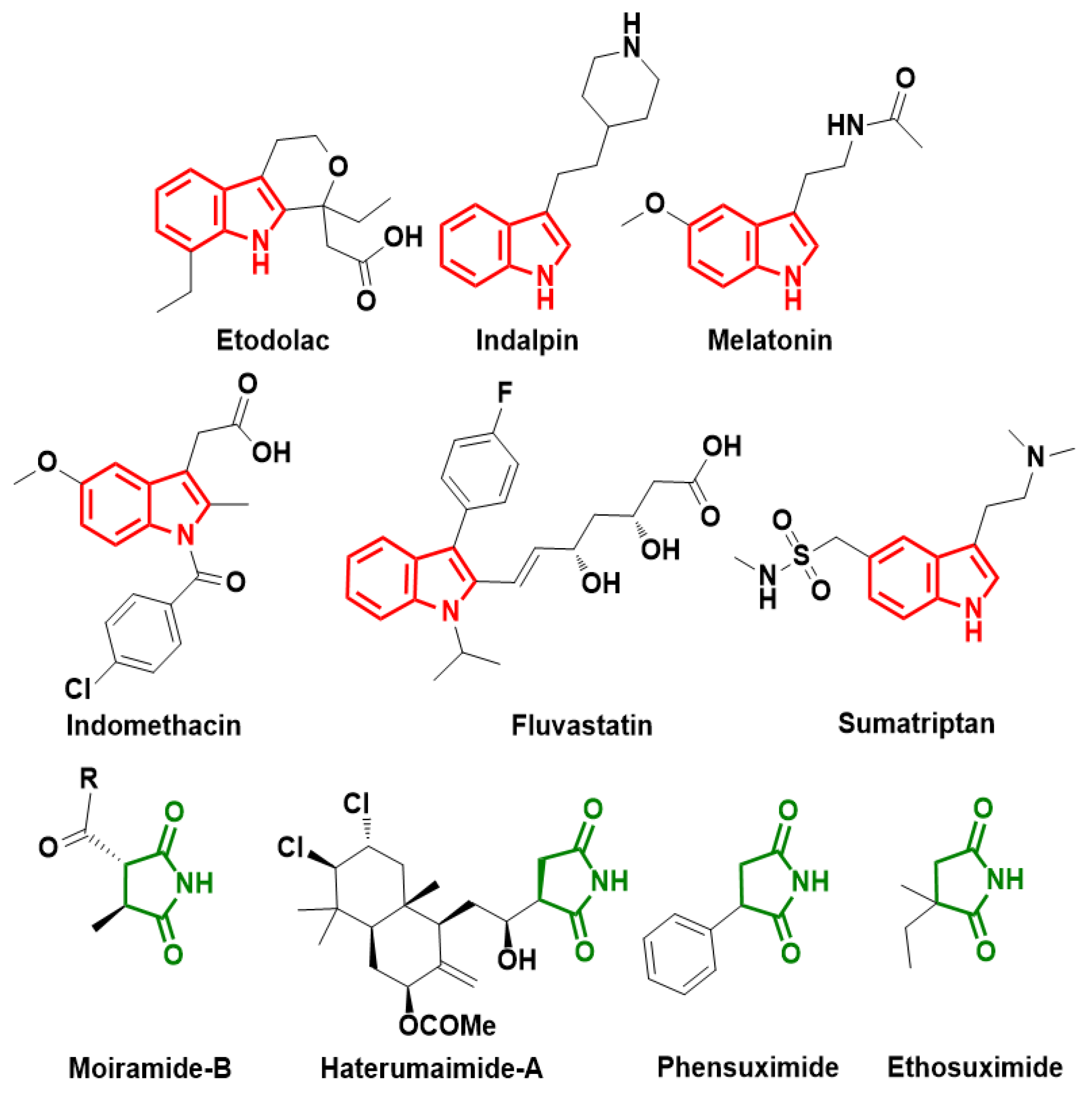
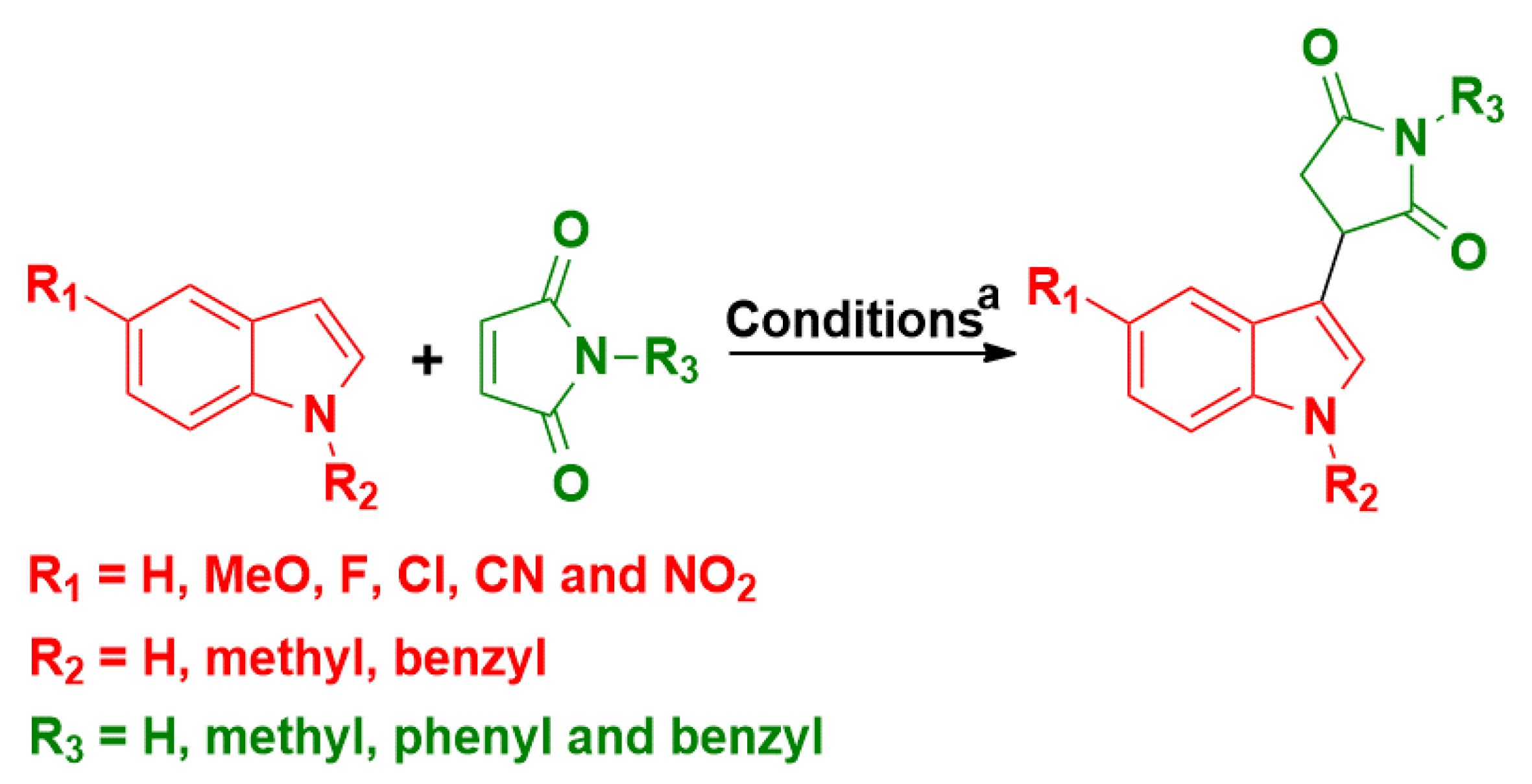
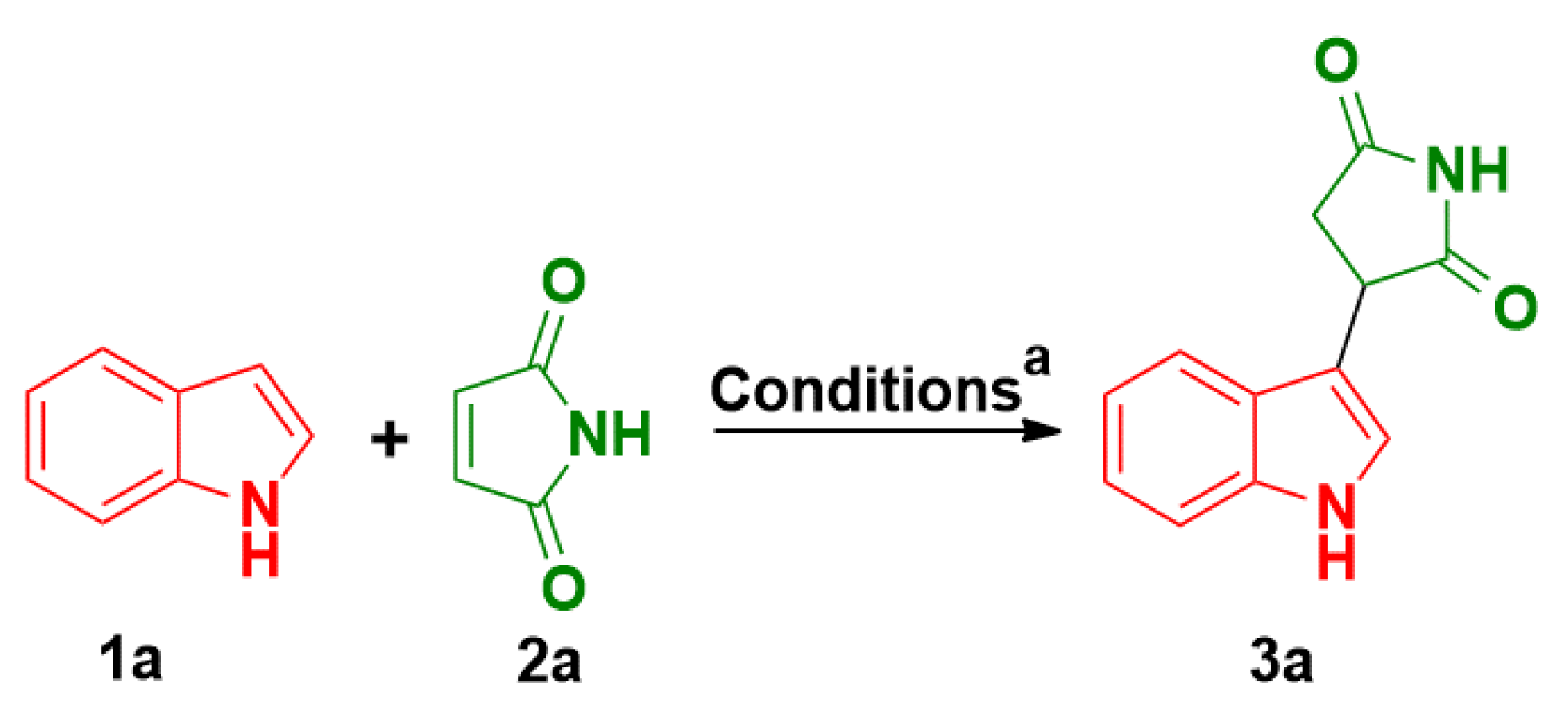
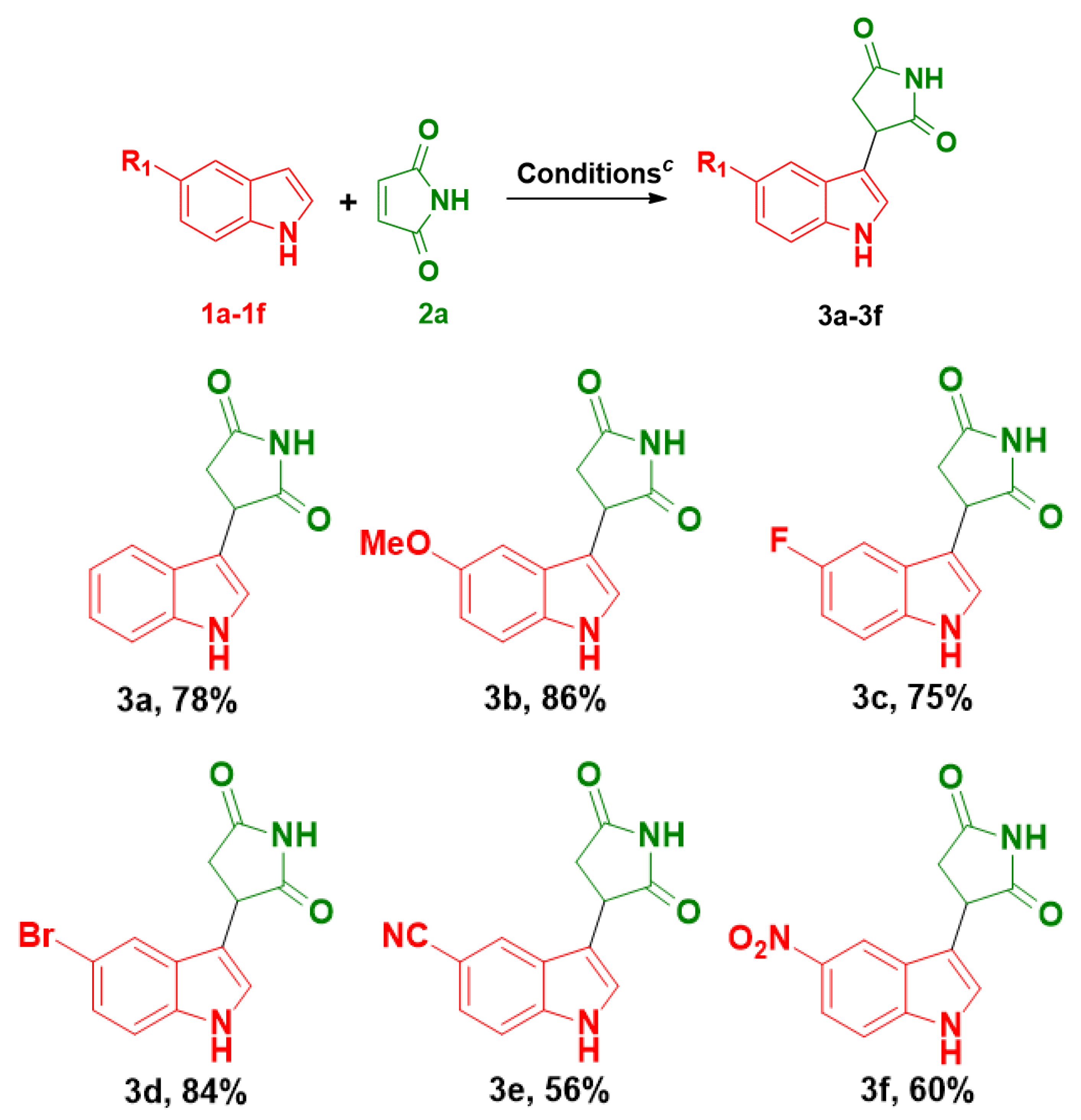
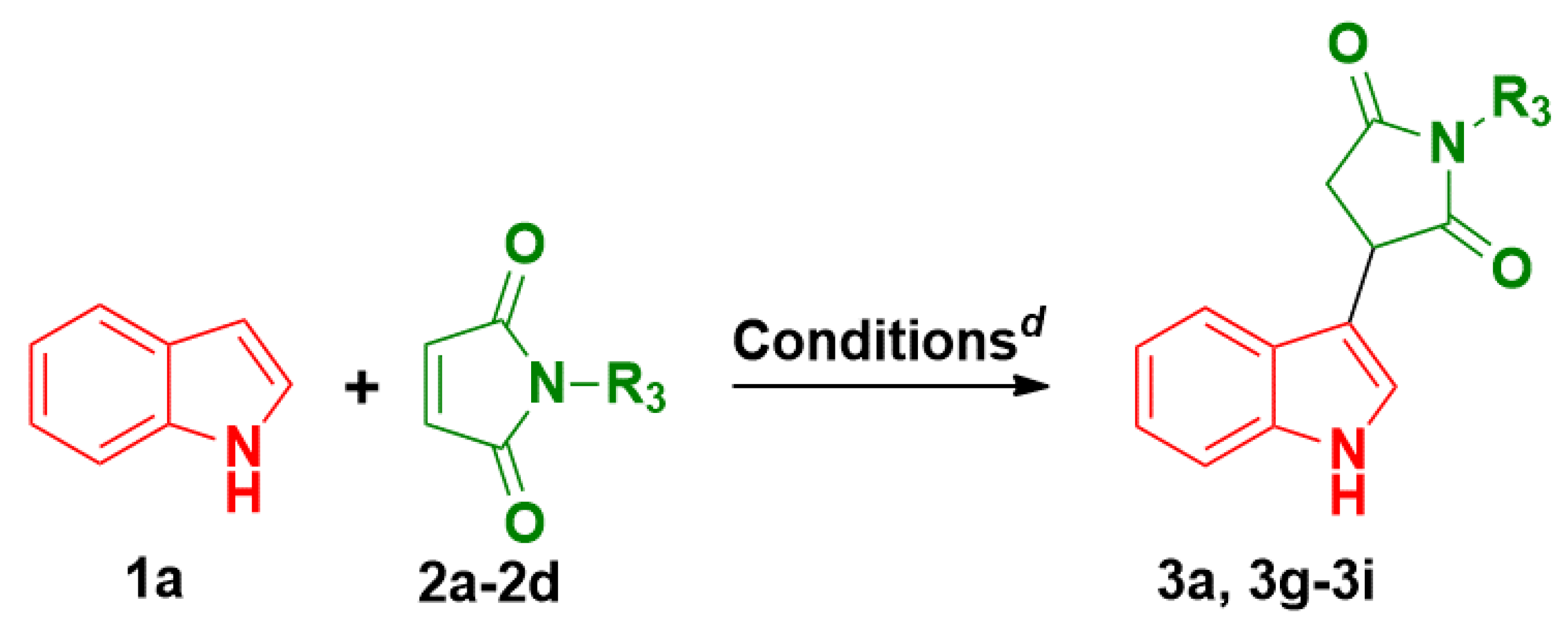

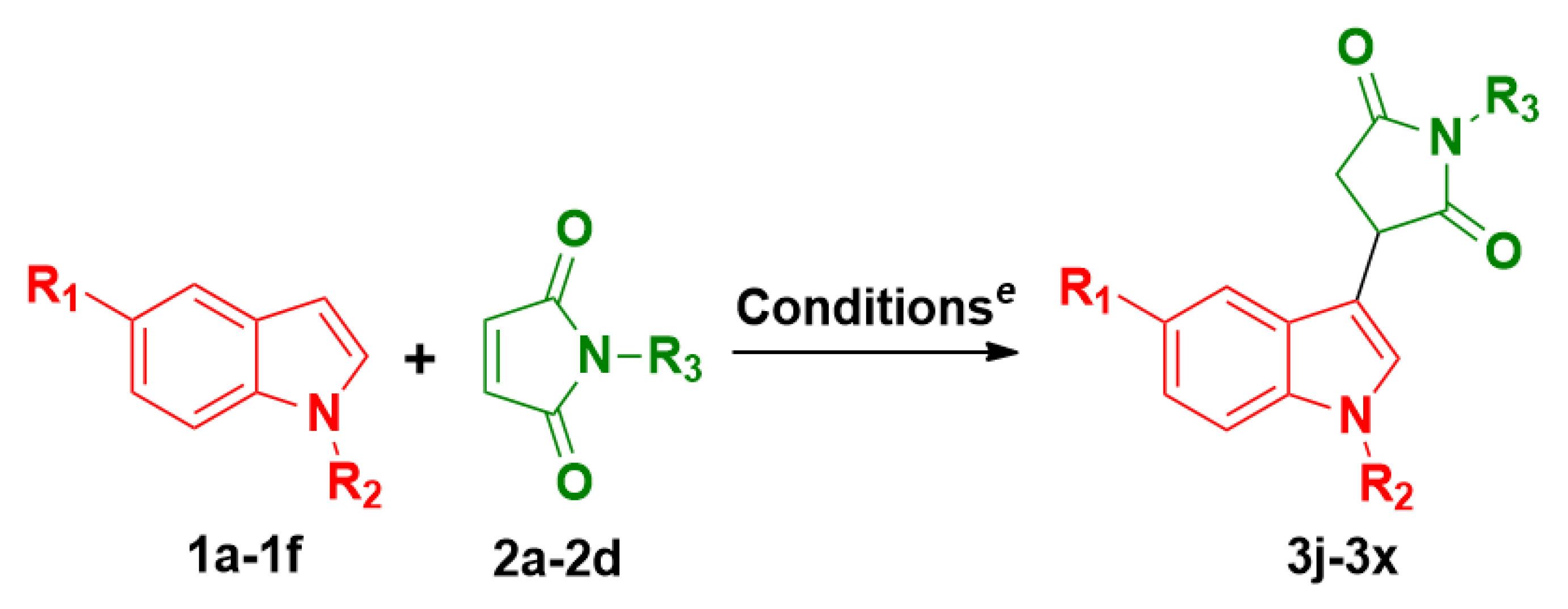
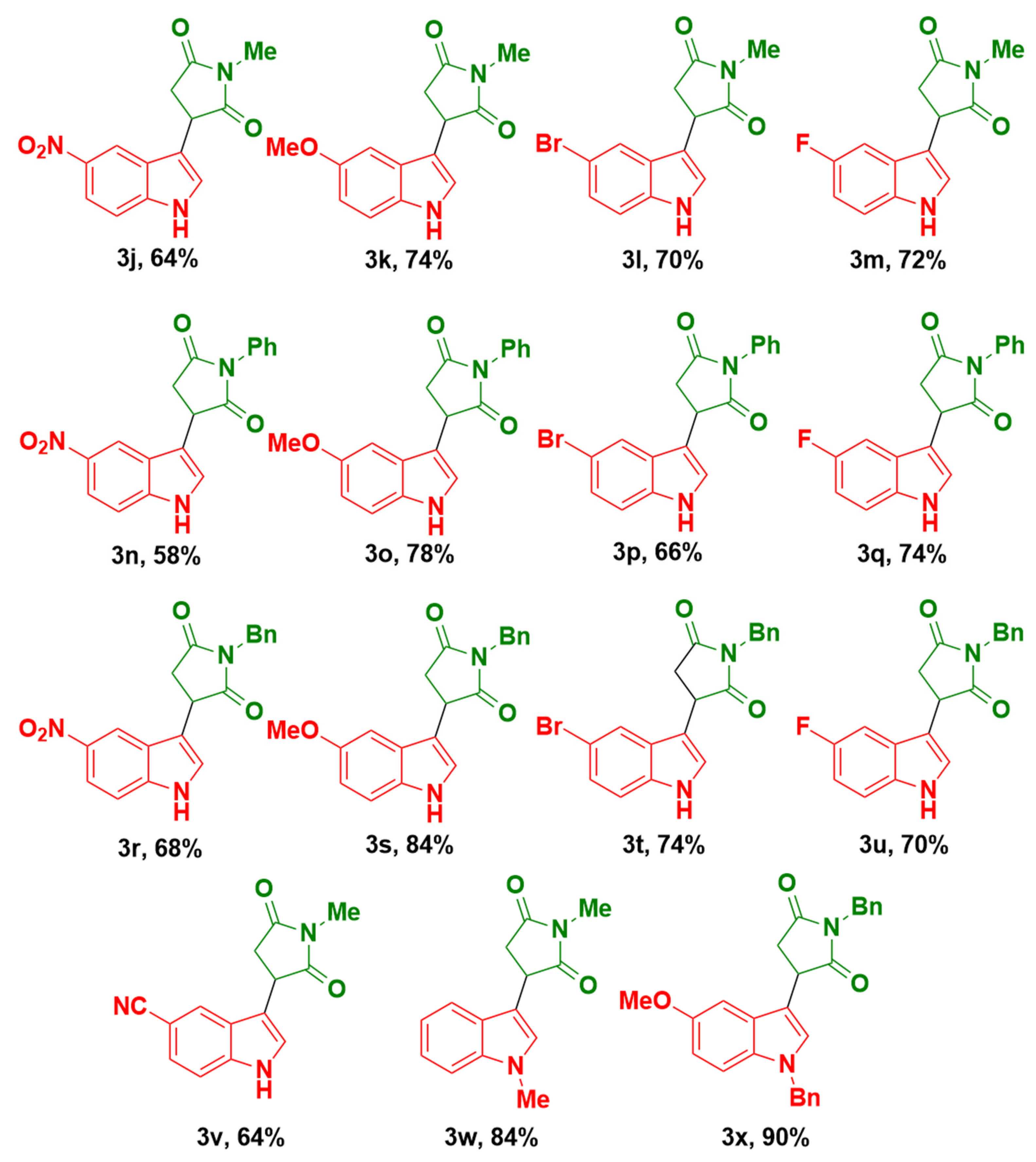

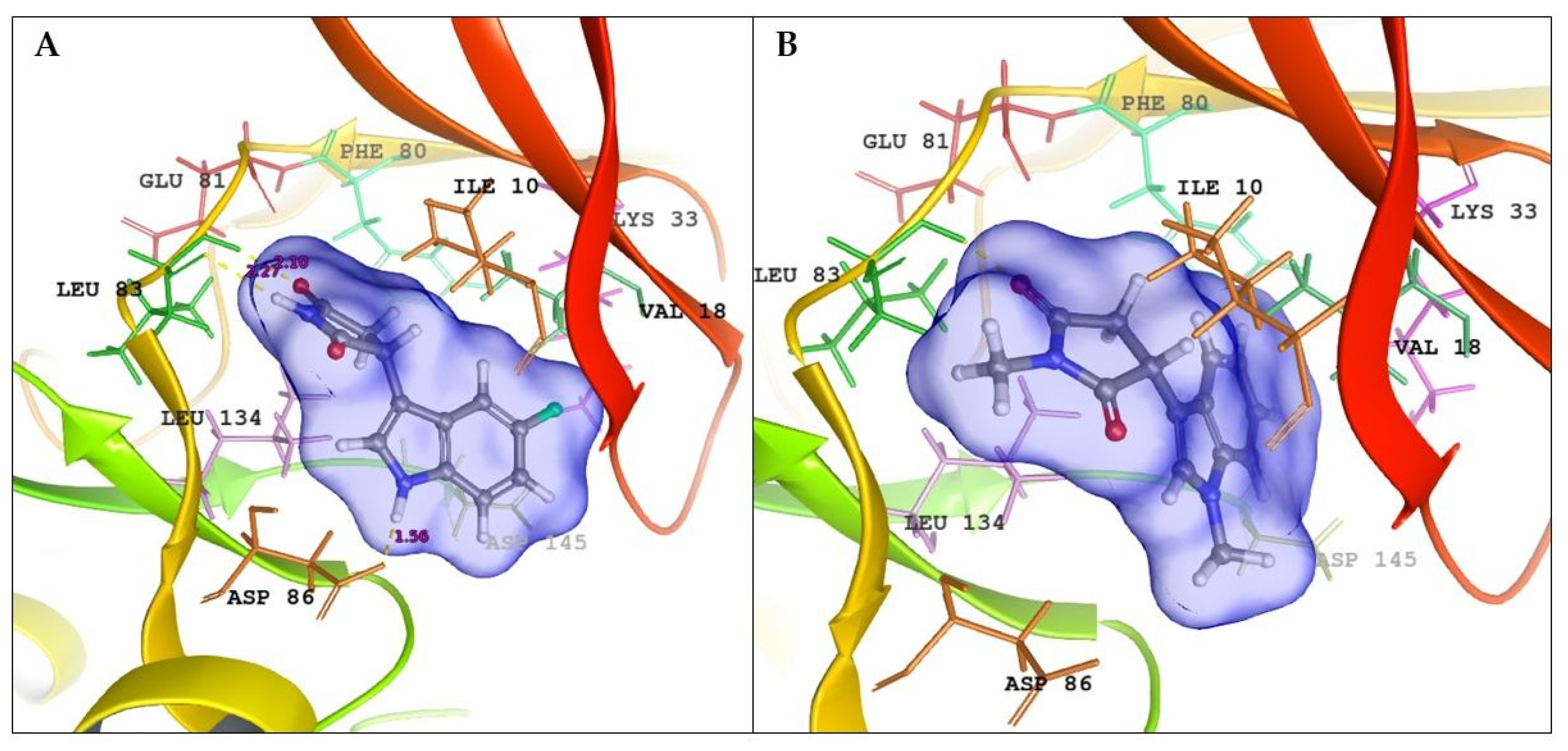
| Entry | Catalyst | Solvent * | Temp (°C) | Time (h) | Yield(%) b |
|---|---|---|---|---|---|
| 1 | - | DCE | r.t/60 c | 12 | 0 |
| 2 | I2 | EtOH | r.t/60 | 12 | 5 |
| 3 | I2 | MeOH | r.t/60 | 12 | 18 |
| 4 | I2 | MeCN | r.t/60 | 12 | 25 |
| 5 | ZnCl2 | MeCN | r.t/60 | 12 | trace |
| 6 | ZnCl2 | DCE | r.t/60 | 12 | 10 |
| 7 | ZnCl2 | EtOAc | r.t/60 | 12 | trace |
| 8 | Cu(OAc)2 | MeCN | r.t/60 | 12 | N.R |
| 9 | Cu(OTf)2 | MeCN | r.t/60 | 12 | N.R |
| 10 | Cu(NO3)2 | MeCN | r.t/60 | 12 | trace |
| 11 | AgCl | MeCN | r.t/60 | 12 | N.R |
| 12 | AgOTf | MeCN | r.t/60 | 12 | N.R |
| 13 | CAN | MeCN | r.t/60 | 12 | N.R |
| 14 | H3BO3 | MeCN | r.t/60 | 12 | 0 |
| 15 | BF3OEt2 | MeCN | r.t | 12 | 30 |
| 16 | BF3OEt2 | MeCN | 60 | 12 | 52 |
| 17 | BF3OEt2 | MeOH | 60 | 12 | 44 |
| 18 | BF3OEt2 | DCE | 60 | 12 | 62 |
| 19 | BF3OEt2 | EtOAc | 60 | 6 | 78 |
| Entry | Compound | Cancer Cell Lines (IC50 µ/M) f | ||
|---|---|---|---|---|
| HT-29 g | Hepg2 h | A549 i | ||
| 1 | 3a | 4.32 (±0.06) | 5.2 (±0.03) | 10.9 (±0.03) |
| 2 | 3b | 4.67 (±0.16) | 03.6 (±0.02) | 9.7 (±0.22) |
| 3 | 3c | 4.36 (±0.33) | 05.8 (±0.03) | 2.1 (±0.20) |
| 4 | 3d | 7.9 (±0.32) | 09.1 (±0.04) | 6.4 (±0.14) |
| 5 | 3e | 06.2 (±0.23) | 05.6 (±0.06) | 18.2 (±0.22) |
| 6 | 3f | 05.4 (±0.13) | 04.9 (±0.01) | 10.7 (±0.05) |
| 7 | 3g | 10.7 (±0.23) | 11.4 (±0.03) | 9.6 (±0.13) |
| 8 | 3h | 08.4 (±0.06) | 15.9 (±0.03) | 10.6 (±0.34) |
| 9 | 3i | 24.8 (±0.02) | 20.3 (±0.03) | 1.5 (±0.45) |
| 10 | 3j | 07.8 (±0.03) | 06.9 (±0.11) | 9.1 (±0.33) |
| 11 | 3k | 10.6 (±0.12) | 13.0 (±0.13) | 2.5 (±0.12) |
| 12 | 3l | 10.9(±0.03) | 13.6 (±0.035) | 3.9 (±0.34) |
| 13 | 3m | 19.9 (±0.12) | 14.5 (±0.6) | 3.5 (±0.01) |
| 14 | 3n | 09.1(±0.06) | 7.8 (±0.21) | 12.9 (±0.22) |
| 15 | 3o | 06.6(±0.4) | 16.5 (±0.22) | 14.4 (±0.03) |
| 16 | 3p | 12.5±0.03 | 18.7 (±0.20) | 11.3 (±0.03) |
| 17 | 3q | 10.2 (±0.33) | 5.9 (±0.05) | 7.6 (±0.03) |
| 18 | 3r | 10.3 (±0.45) | 12.5 (±0.07) | 8.7 (±0.06) |
| 19 | 3s | 23.6 (±0.67) | 19.5 (±0.56) | 15.8 (±0.22) |
| 20 | 3t | 22.5 (±0.34) | 18.6 (±0.05) | 11.4 (±0.17) |
| 21 | 3u | 10.7 (±0.23) | 16.7 (±0.67) | 2.4 (±0.14) |
| 22 | 3v | 08.5 (±0.13) | 07.2 (±0.09) | 3.6 (±0.24) |
| 23 | 3w | 0.02 (±0.02) | 0.8 (±0.05) | 6.3 (±0.12) |
| 24 | 3x | 28.2 (±0.34) | 17.3 (±0.22) | 14.7 (±0.12) |
| 25 | Doxorubicin | 01.2 (±0.03) | 01.8 (±0.01) | 0.9 (±0.10) |
Publisher’s Note: MDPI stays neutral with regard to jurisdictional claims in published maps and institutional affiliations. |
© 2021 by the authors. Licensee MDPI, Basel, Switzerland. This article is an open access article distributed under the terms and conditions of the Creative Commons Attribution (CC BY) license (https://creativecommons.org/licenses/by/4.0/).
Share and Cite
Shaikh, I.N.; Rahim, A.; Faazil, S.; Adil, S.F.; Assal, M.E.; Hatshan, M.R. BF3-OEt2 Catalyzed C3-Alkylation of Indole: Synthesis of Indolylsuccinimidesand Their Cytotoxicity Studies. Molecules 2021, 26, 2202. https://doi.org/10.3390/molecules26082202
Shaikh IN, Rahim A, Faazil S, Adil SF, Assal ME, Hatshan MR. BF3-OEt2 Catalyzed C3-Alkylation of Indole: Synthesis of Indolylsuccinimidesand Their Cytotoxicity Studies. Molecules. 2021; 26(8):2202. https://doi.org/10.3390/molecules26082202
Chicago/Turabian StyleShaikh, Iqbal N., Abdul Rahim, Shaikh Faazil, Syed Farooq Adil, Mohamed E. Assal, and Mohammad Rafe Hatshan. 2021. "BF3-OEt2 Catalyzed C3-Alkylation of Indole: Synthesis of Indolylsuccinimidesand Their Cytotoxicity Studies" Molecules 26, no. 8: 2202. https://doi.org/10.3390/molecules26082202
APA StyleShaikh, I. N., Rahim, A., Faazil, S., Adil, S. F., Assal, M. E., & Hatshan, M. R. (2021). BF3-OEt2 Catalyzed C3-Alkylation of Indole: Synthesis of Indolylsuccinimidesand Their Cytotoxicity Studies. Molecules, 26(8), 2202. https://doi.org/10.3390/molecules26082202








